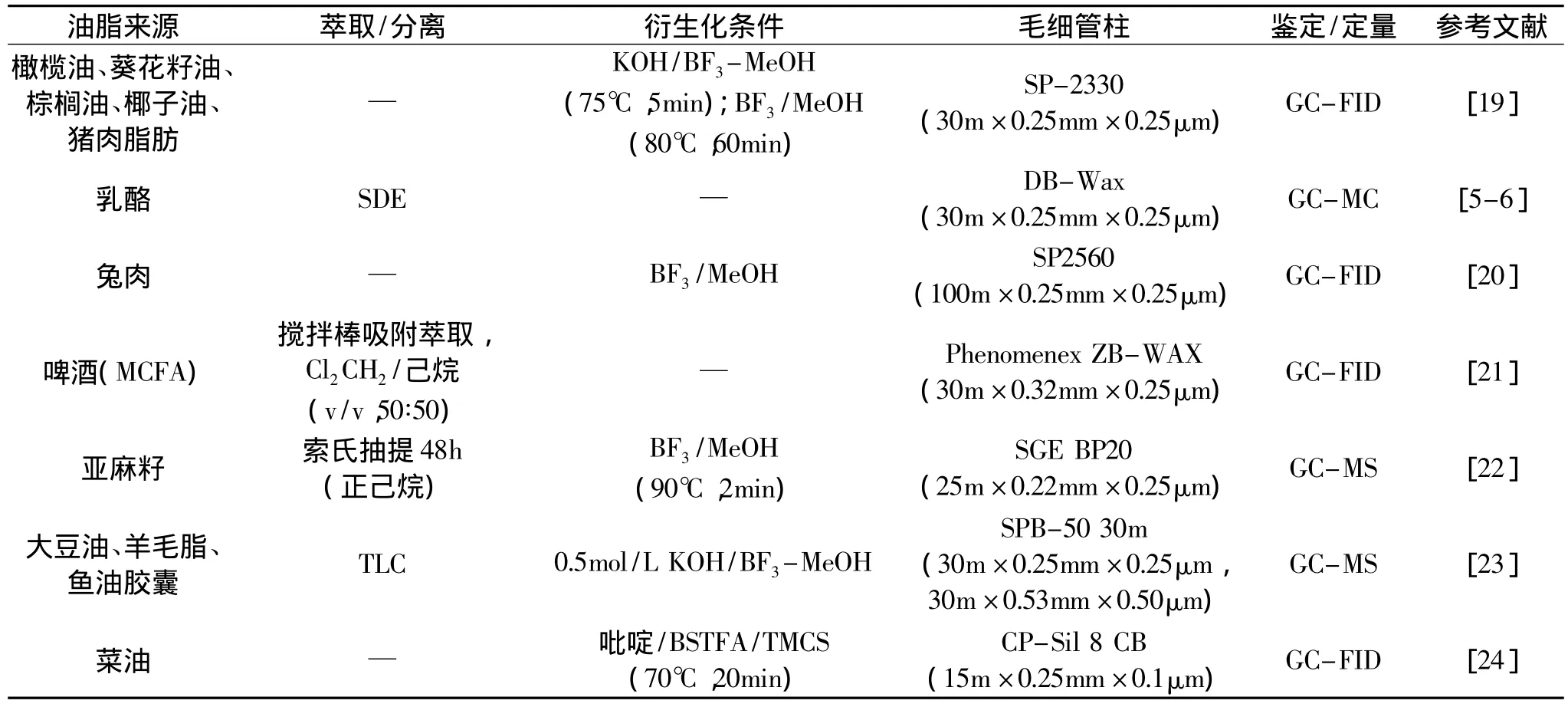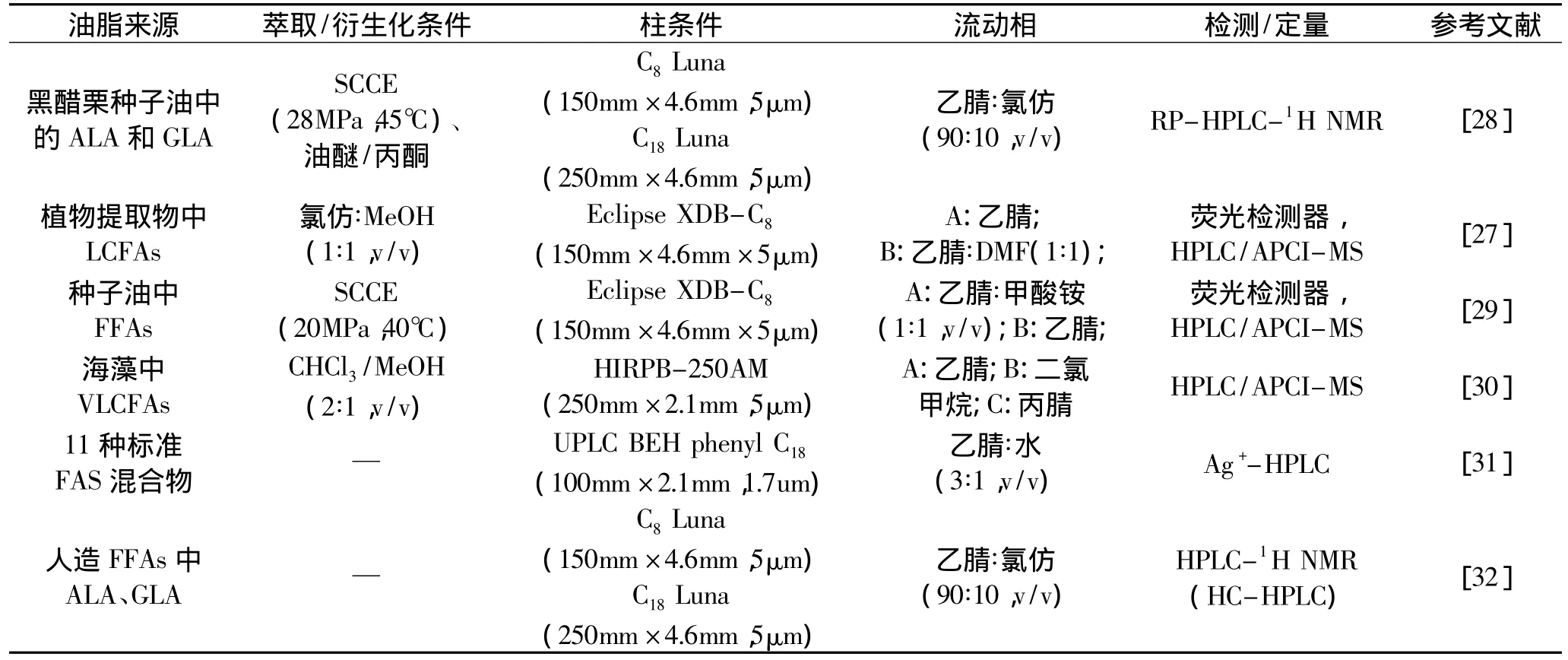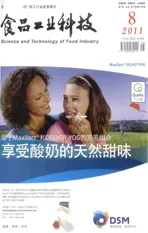脂肪酸分析方法研究进展
2011-11-06高瑞萍彭见林赵国华
高瑞萍,彭见林,刘 辉,赵国华,*
(1.西南大学食品科学学院,重庆400715; 2.重庆市农产品加工技术重点实验室,重庆400715)
脂肪酸分析方法研究进展
高瑞萍1,2,彭见林1,2,刘 辉1,2,赵国华1,2,*
(1.西南大学食品科学学院,重庆400715; 2.重庆市农产品加工技术重点实验室,重庆400715)
脂肪酸的过量摄入会引发一些慢性疾病,如肥胖、糖尿病、心血管疾病等,严重危害人体健康。而适量不饱和脂肪酸的摄入,包括 α-亚麻酸(α-linolenic acids,ALA)、花生四烯酸(arachidonic acid,AA)、二十碳二烯酸(eicosapentaenoic acid,EPA)等不仅有益于身体健康,还能改善机体功能。国外对脂肪酸的分析已相当成熟,应用了许多现代分析技术。鉴于脂肪酸在食品领域的重要性,重点对国外脂肪酸(fatty acids,FAs)的分析方法进行综述,包括萃取和分析等方面的内容。以期为加快国内脂肪酸分析技术的发展提供有益参考。
脂肪酸,游离脂肪酸,萃取技术,分析方法
1 脂肪萃取技术(fatty acid extraction techniques)
脂肪抽提是脂肪酸分析过程中最关键的步骤。常用的脂肪抽提技术包括索氏抽提(soxhlet)、加压液体萃取、水蒸气蒸馏(steam distillation)等。
1.1 微波辅助索氏抽提(microwave-integrated Soxhlet,MIS)
索氏抽提(Soxhlet extraction)是最常用的脂肪提取技术。但其存在萃取时间较长、溶剂消耗大和可重复性差等缺点。Virot等[2]通过微波辅助对索氏抽提进行改进,可用来抽提含油种子、肉、焙烤等产品中的脂肪。主要利用聚四氟乙烯/石墨搅拌棒使微波产生的热量传播到周围环境中,尤其适用于己烷作为抽提剂的抽提。此法可从花生、葵花籽等食物中提取脂肪,通常萃取32min后,食品基质中总脂肪即可分离浓缩,而传统的索氏抽提需要8h。该方法应用微波作为不连续热源具有以下优点:有效加热、较快的能量转化、减小设备尺寸、对热控制能做出较快的反应、更快速启动、增加得率、减少过程步骤[3]。

表1 不同食品基质中脂肪酸萃取技术
1.2 同时蒸馏萃取(Simultaneous distillationextraction,SDE)技术
该方法适用于分析含香气成分较少的样品。Larrayoz等[4]成功应用SDE萃取山羊奶酪中的中链和长链脂肪酸。Careri等[5]用SDE来提取帕尔马奶酪中的FFA。优化出实验条件时间为3h,样品和溶剂加热温度分别为125℃和55℃。Alewijn等[6]研究了一种快速而简单的SDE萃取奶酪中脂肪衍生物和低挥发性组分的方法。应用乙腈作为提取剂,45℃下提取10min,在三种奶酪中分析到存在23种FAs,其中大部分是中链FAs。
1.3 自动酸水解萃取(aotomated acid hydrolysisextraction,AHE)技术
AOAC996.01方法是萃取谷物中总脂肪、饱和脂肪酸、单不饱和脂肪酸、多不饱和脂肪酸的分析方法。但是该方法存在步骤繁琐、溶剂使用量大、操作时间长等缺点。AHE是在密闭体系中联合使用自动酸水解和洗涤样品,然后通过溶剂回流和自动索氏抽提油脂。Robinson等[7]通过比较AOAC996.01和AHE得出AHE具有减少溶剂使用量、减少操作者与试剂接触、减少操作时间和缩小误差等优点。由于AHE系统是自动和密闭的,样品较少接触和暴露在空气中。另外,六个样品能在一个体系中同时进行分析,每个样品消耗较少的溶剂,80%的溶剂能被回收和再利用[8]。
1.4 加压液体萃取技术 (pressurized liquid extraction,PLE)
PLE萃取是将固体样品装入一个提取容器中,然后原料在高压(3.5~20MPa)下用有机溶剂提取,加热温度超过沸点。和传统的分析方法比较,PLE具有提取时间短、提取率高、自动化、减少人体接触溶剂和较少溶剂的使用量等优点,是一种在常规分析食品等基质中油脂/脂肪酸最有效的方法[9]。Poerschmann等[10]应用PLE提取海洋浮游植物中的脂肪酸,并与超声波辅助(ultrasound-assisted,USE)和经典索氏抽提进行比较。在PLE中提取压力为10MPa,应用的溶剂为甲醇和石油醚,两种溶剂提取的最佳温度分别为85℃和150℃,萃取时间都为10min。结果表明,PLE大大降低了总抽提时间、溶剂的量和对样品和溶剂的操作。
1.5 超临界 CO2萃取技术(supercritical carbon dioxide extraction,SCCE)
超临界CO2萃取技术是利用CO2处于超临界状态而萃取分离各种有机物的一种先进技术。由于其无毒、无污染、分离简单,因而被广泛应用于天然油脂的提取、分离。张文叶等[11]利用超临界CO2流体萃取技术萃取山胡萝卜籽油,萃取压力为25MPa、温度为40℃、时间为80min,得油率为36.65%。郑美瑜[12]用超临界 CO2流体连续萃取鱼油中的 EPA、DHA,实验得出压力为12.5MPa、温度为45~90℃、鱼油量4mL/min、CO2流量为40L/min时的萃取效果最佳。Cao等[13]采用超临界CO2萃取、微波辅助流体萃取(microwave-assisted reflux extraction,MWRE)、超声波辅助萃取(ultrasound-assisted extraction,USE)、溶剂流体萃取(solvent reflux extraction,SRE)四种方法提取微孔草种子油,其中MWRE、USE、SRE中氯仿作为萃取溶剂,结果四种方法浸提率分别为34.0%、13.12%、7.35%、12.16%。经反相HPLC分析得39种脂肪酸衍生物的检测限为0.014~14.29μmol/L、线性相关性>0.9992。结果表明 SCCE是一种比MWRE、USE和SRE更有效、更适合于萃取食品和药品样品中脂肪酸的方法。
2 脂肪酸分析方法
2.1 气相色谱法
毛细管 GC(Capillary GC)是最常用的分析FAMEs的技术。GC是一种分析油、脂肪和加工油和脂肪中甲基酯化的脂肪酸的较好的技术。Guil-Guerrero等[15]分析19种种子油中γ-亚油酸(18∶3,ω-6)和十八碳四烯酸(18∶4,ω-3),采用两种类型的毛细管柱:一种是较高极性的SP-2330柱联合FID检测器,另一种是甲基硅酮HP-1柱联合MS检测器来检测双键,测得γ-亚油酸含量为1.77%~5.02%,十八碳四烯酸含量为3.03%~12.94%。Cherif等[16]应用极性DB-WAX柱测定地中海海岸的螃蟹中的脂肪酸组成,结果得螃蟹肉和肝脏中饱和脂肪酸含量分别为22.58%~13.49%和25.25%~26.24%,主要的饱和脂肪酸为棕榈酸(16∶0)和硬脂酸(18∶0),油酸(18∶1)为主要的不饱和脂肪酸,花生四烯酸(20:4n-6)为主要的PUFA。Fernández-García等[17]研究了不同的西班牙半熟化和熟化的乳酪脂类分解程度和类型,应用极性FFAP(CP-Wax 58)柱(30m×0.32mm×0.25μm),结果发现除中链脂肪酸(C10∶0~C14∶0)外,乳酪中的FFAs的浓度有很大的不同,结果也证明随着熟化时间增加,FFAs的浓度也增加。Poveda&Cabezas[18]研究西班牙不同地区的山羊乳酪的FFAs的组成,发现含量最多的FFAs是油酸、棕榈酸、硬脂酸和肉豆蔻酸,占总FFAs的85%。

表2 GC测定样品中的脂肪酸

表3 HPLC测定样品中的脂肪酸
2.2 HPLC
HPLC是常用分析和分离脂肪酸的方法。和GC相比,HPLC允许脂肪酸转化为不同的衍生物,所以HPLC方法被用来分析饱和脂肪酸和不饱和脂肪酸,利用柱前衍生,增加检测的灵敏度和选择性。衍生能够克服因拖尾、形成较小极性物质而降低检测的灵敏度等。但也有步骤冗长和繁琐的清洗过程等缺点,例如液-液萃取,在衍生化之前需要对生物材料中脂肪酸进行定量分离,需要较长的时间,生物活性PUFAs如γ-亚麻酸、EPA、AA和DHA不能完全分离[25]。衍生化试剂2-NPH HCl用来测定食品和饮料中的脂肪酸[26]。所有的脂肪酸,包括饱和、不饱和脂肪酸对2-NPH HCl敏感。这些组分在230nm处有较强的吸光度,所以允许使用UV检测器。同时,酸介质中在400nm处具有最大吸光度。用这种衍生试剂的好处是过量的试剂和反应副产物不会干扰HPLC分析,这是由于在400nm处它们不吸收可见光[27]。
2.3 近红外光谱技术(Near-Infrared Reflectance Spectroscopy,NIRS)
近年来,随着脂肪酸研究的深入,不断有新的分析方法应用到脂肪酸的研究中。其中NIRS由于具有方便、快速、高效、准确、无污染、低成本、不破坏样品、不消耗化学试剂和一次可测定多种样品等特点,在脂肪酸分析中得到广泛应用。
Patil等[33]应用近红外透射光谱技术(Near-Infrared Transmittance Spectroscopy,NTTS)分析 612种完整大豆粒中脂肪酸组成,光谱范围 850~1048nm,结果得出油酸r2、SEP分别为0.89、1.61,亚油酸r2和SEP分别为0.86、1.50,棕榈酸r2和SEP分别为0.89、0.17,结果较好。但对亚麻酸r2和SEP分别为0.78、0.36,硬脂酸r2和SEP分别为0.63、0.11,结果相对较差。Coppa等[34]用NIRS预测114个牛奶样品中脂肪酸组分,结果得出,NIRS对测定微波干燥的牛奶中饱和脂肪酸、单不饱和脂肪酸、反式脂肪酸、反式/顺式C18∶1、硬脂酸、花生酸效果较好,外部验证决定系数(coefficient of determination in external validation,R2V)>0.88;但对亚油酸、亚麻酸、总n-6和n-3脂肪酸效果较差,R2V<0.81。NIRS比较适合测液态奶中饱和脂肪酸、单不饱和脂肪酸、棕榈酸、油酸。Pérez-Marín等[35]应用NIRS分析猪活体、胴体、带皮的脂肪、不带皮的脂肪中棕榈酸、硬脂酸、油酸、亚油酸,结果表明NIRS在线监测和控制活猪和胴体中的脂肪具有较好的效果。Peng等[36]用NIRS分析固态发酵基质中单细胞油,得出R2>0.9552,预测标准误差平方根小于0.5772%,结果表明NIRS是一种用来分析固态发酵基质中脂肪酸的快速、无损、方便的技术。
3 展望
随着人们对油脂中有害脂肪酸(如反式脂肪酸)和生物活性脂肪酸(DHA、EPA等)的高度重视,对食品中脂肪酸的分析也成为研究的热点。HPLC和GC等方法的分析过程较为复杂,包括许多样品前处理,近红外具有无损、快速、无污染等优点,但也存在一定的缺陷。由于脂肪酸组分较复杂,给分析工作带来了一定的困难,但我们坚信在研究者的不断努力下,对脂肪酸的分析将迈上新的台阶。
[1]刘佩,沈生荣,何国庆,等.共轭亚油酸的生理学功能及健康意义[J].中国粮油学报,2009,24(6):161-165.
[2]Virot M,Tomao V,Ginies C,et al.Microwave-integrated extraction of total fats and oils[J].Journal of Chromatography A,2008,1196-1197:57-64.
[3]Albala-Hurtado S,Pascual-Sastre L E,Vidal-Carou M C,et al.Comparision of Two Fat Extraction Methods in Powdered Infant Milks[J].Journal of Food Composition and Analysis,1999,12 (4):333-337.
[4]Larrayoz P,Addis M,Gauch R,et al.Comparsion of dynamic headspace and simultaneous distillation extraction techniques used for the analysis of the volatile components in three European PDO ewes’s milk cheeses[J].International Dairy Journal,2001,11 (11-12):911-926.
[5]Careri M,Mangia A,Mori G,et al.A new multivariate approach for the optimization of the simultaneous distillationextraction technique for free fatty acids using a face centred cube experimental design:application to Parmigiano-Reggiano cheese[J].Analytica Chimica Acta,1999,386(1-2):169-180.
[6]Alewijn M,Sliwinski E L,Wouters J T M.A fast and simple method for quantitative determination of fat-derived medium and low-volatile compounds in cheese[J].International Dairy Journal,2003,13(9):733-741.
[7]Robinson J E,Singh R,Kays S E.Evaluation of an automated hydrolysis and extraction for quantification of total fat,lipid classes and trans fat in cereal products[J].Food Chemistry,2008,107(3):1144-1150.
[8]Abrha Y,Raghavan D.Polychlorinated biphenyl(PCB) recovery from spiked organic matrix using accelerated solvent extraction(ASE)and Soxhelt extraction[J].Journal of Hazardous Materials B,2000,80(1-3):147-157.
[9]Bjorklund E,Nilsson T.Pressurised liquid extraction of persistent organic pollutants in environmental analysis[J].Trend in Analytical Chemistry,2000,19(7):434-445.
[10]Poerschmann J,Carlson R.New fractionation scheme for lipid classes based on“in-cell fractionation”using sequential pressurized liquid extraction[J].Journal of Chromatography A,2006,1127(1-2):18-25.
[11]张文叶,张峻松,贾春晓,等.超临界CO2流体萃取山胡萝卜籽油的脂肪酸成分分析[J].中国粮油学报,2009,24(9): 87-89.
[12]郑美瑜.超临界CO2连续式萃取精馏鱼油中EPA和DHA的实验研究[J].食品科学,2002,23(4):76-78.
[13]Cao Y,Suo Y.Extraction of Microula sikkimensis seed oil and simultaneous analysis of saturated and unsaturated fatty acids by fluorescence dection with reversed-phased HPLC[J].Journal of Food Composition and Analysis,2010,23(4):100-106.
[14]Schafer K.Accelerate solvent extraction of lipids for determining the fatty acid composition of biological material[J]. Analytica Chimica Acta,1998,358(1):69-77.
[15]Guil-Guerrero J L,Gomez-Mercado F,Garcia-Maroto F,et al.Occurrence and characterization of oils rich in γ-linolenic acid PartⅠ:Echium seeds from Macaronesia[J].Phytochemistry,2000,53:451-456.
[16]Cherif S,Frikha F,Gargouri Y,et al.Fatty acid composition of green crab(Carcinusmediterraneus)from theTunisian Mediterranean coasts[J].Food Chemistry,2008,111(4): 930-933.
[17]Ferna'ndez-Garcı'a E,Carbonell M,Calzada J,et al. Seasonal variation of the free fatty acids contents of Spanish ovine milk cheeses protechted by a designation of origin:A comparative study[J].International Dairy Journal,2006,16(3):252-261.
[18]Poveda J M,Cabezas L.Free fatty acid composition of regionally-produced Spanish goat cheese and relationship with sensory characteristiscs[J].Food Chemistry,2006,95(2): 307-311.
[19]Eras J,Montanes F,Ferran J,et al.Chlorotrimethylsilane as a reagent for gas chromatographic analysis of fats and oils[J]. Journal of Chromatography A,2001,918(1):227-232.
[20]Forrester-Anderson I T,McNitt J,Way R,et al.Fatty acid content of pasture-reared fryer rabbit meat[J].Journal of Food Composition and Analysis,2006,19(6-7):715-719.
[21]Hor'ak T,ˇCul'ık J,Jurkov'a M,et al.Determination of free medium-chain fatty acids in beer by stir bar sorptive extraction[J].Journal of Chromatography A,2008,1196-1197:96-99.
[22]Cunha A C,Fernandes-Ferreira M.Ontogenic variations in free and esterified fatty acids during somatic embryogenesis of flax (Linum usitatissimum L.)[J].Plant Science,2003,164(5): 863-872.
[23]Yamamoto K,Kinoshita A,Shibahara A.Gas chromatographic separation of fatty acid methyl esters on weakly polar capillary columns[J].Journal of Chromatography A,2008,1182(1): 132-135.
[24]Verleyen T,Verhe R,Garcia L,et al.Gas chromatographic characterization of vegetable oil deodorization distillate[J].Journal of Chromatography A,2001,921(2):277-285.
[25]MiwaH.High-performanceliquid chromatographic determination of free fatty acids and esterified fatty acids in biological materials as their 2-nitrophenylhydrazides[J]. Analytica Chimica Acta,2002,465(1-2):237-255.
[26]Poveda J M,Cabezas L.Free fatty acid composition of regionally-produced Spanish goat cheese and relationship with sensory characteristics[J].Food Chemistry,2006,95(2): 307-311.
[27]You J,Zhao X N,Suo Y R,et al.Determination of longchain fatty acids in bryophyte plants extracts by HPLC with fluorescence detection and identification with MS[J].Journal of Chromatography B,2007,848(2):283-291.
[28]B'artlov'a M,Bern'aˇsek P,S'ykora J,et al.HPLC in reversed phasemode:Toolforinvestigation ofkineticsof blackcurrant seed oil lipolysis in supercritical carbon dioxide[J]. Journal of Chromatography B,2006,839(1-2):80-84.
[29]Wang H L,Suo Y R,Wang X Y,et al.Extraction of Nitraria tangutorum seed oilby supercriticalcarbon dioxide and determination of free determination of free fatty acids by HPLC/ APCI/MS with fluorescence detection[J].Separation and Purification Technology,2007,56(3):371-377.
[30]Rˇezanka T,Nedbalová L,Sigler K.Identification of verylong-chain polyunsaturated fatty acids from Amphidinium carterae by atmospheric pressure chemical ionization liquid chromatography-mass spectroscopy[J].Phytochemistry,2008,69 (12):2391-2399.
[31]Adlof R.Analysis of triacylglycerol and fatty acid isomers by low- temperature silver- ion high performance liquid chromatography with acetonitrile in hexane as solvent:Limitations of the methodology[J].Journal of Chromatography A,2007,1148 (2):256-259.
[32]S'ykora J,Bern'aˇsek P,Zarev'uck'a M,et al.Highperformance liquid chromatography with nuclear magnetic resonance detection-A method for quantificatication of α-and γlinolenic acids in their mixtures with free fatty acids[J].Journal of Chromatography A,2007,1139:152-155.
[33]Patil A G,Oak M D,Taware S P,et al.Nondestructive estimation of fatty acid composition in soybean(Glycine max(L.) Merrill)seeds using Near-Infrared Transmittance Spectroscopy[J].Food Chemistry,2010,120(4):1210-1217.
[34]Coppa M,Ferlay A,Leroux C,et al.Prediction of milk fatty acid composition by near infared reflectance spectroscopy[J]. International Dairy Journal,2010,20(3):182-189.
[35]Pérez-Marín D,Sanz E D P,Guerrero-Ginel J E,et al.A feasibility study on the use of near-infrared spectroscopy for prediction of the fatty acid profile in live Iberian pigs and carcasses[J].Meat Science,2009,83:627-633.
[36]Peng X W,Chen H Z.Rapid estimation of single cell oil coctent of solid-state fermented mass using near-infrared spectroscopy[J].Bioresource Technology,2008,99(18):8869 -8872.
Progress in analysis methods of fatty acids
GAO Rui-ping1,2,PENG Jian-lin1,2,LIU Hui1,2,ZHAO Guo-hua1,2,*
(1.College of Food Science,Southwest University,Chongqing 400715,China; 2.Chongqing Key Laboratory of Agricultural Products Processing,Chongqing 400715,China)
A number of chronic diseases such as obesity,diabetes,cardiovascular disease are caused by taking overdose fatty acids.However,the moderate amount of unsaturayed fatty acids such as α-linolenic acids(ALA),arachidonic acid(AA)and eicosapentaenoic acid(EPA),which not only be beneficial to human health,but also can improve body functions.Analysis methods of fatty acids are quite mature abroad.Analysis methods of fatty acids were reviewed to introduce the extraction and determination methods.The purpose was to provide necessary references to speed the study process of fatty acids of our country.
fatty acids;free fatty acids;extraction technology;analysis methods
Q547
A
1002-0306(2011)08-0473-05
脂肪酸是组成油脂的脂肪族一元羧酸,根据双键数目可分为饱和脂肪酸、单不饱和脂肪酸、多不饱和脂肪酸(polyunsaturayed fatty acids,PUFAs)。其链长度也不同,由4~28个碳组成,长链脂肪酸碳链上碳原子数大于16,包括多不饱和脂肪酸,其链上包括2个或更多的双键,包括ω-3族和ω-6族。近年来,人们发现食用较多油脂会造成高血脂、高胆固醇、肥胖、糖尿病等疾病。由此,国外相继开发出一大类新型营养保健型油脂,其功能主要有降胆固醇、降血脂、减肥、抗癌等保健功能,其中的主要功效成分即为PUFAs,如亚油酸、亚麻酸、花生四烯酸、EPA、DHA、磷脂及现在兴起的结构油脂等[1]。上述脂肪酸可能会以自由形式存在,但一般它们都是和其他复杂分子以酯键或酰胺键结合。最常用的分析游离脂肪酸(free fatty acids,FFA)的步骤包括:a.样品中脂类物质提取;b.油脂中FFA分离[薄层色谱法(thin -layer chromatography,TLC)、固相微萃取(solidphase ertraction,SPE)];c.FFA衍生为脂肪酸甲酯(fatty acid methyl esters,FAMEs);d.脂肪酸甲酯提取及分析。脂肪酸的测定大多数是通过毛细管气相色谱法(capillary gas chromatography,GC),HPLC分析方法,另外还有无损的近红外分析方法。本文对国内外FAs的分析方法进行综述,着重介绍脂类物质的提取和最新的分析方法(GC、HPLC和NIRS),以期为加快国内脂肪酸分析技术的发展提供一定的参考。
2010-07-23 *通讯联系人
高瑞萍(1987-),女,硕士研究生,研究方向:食品化学与营养学。
